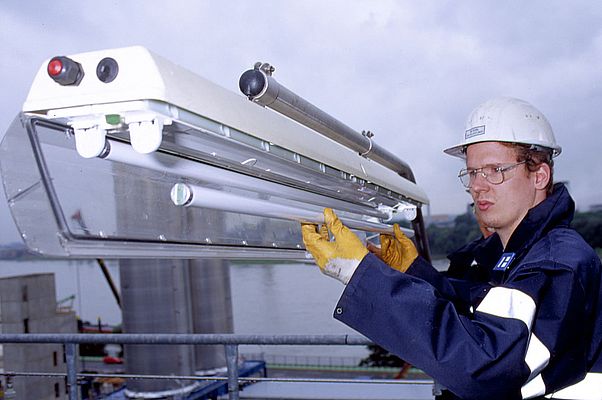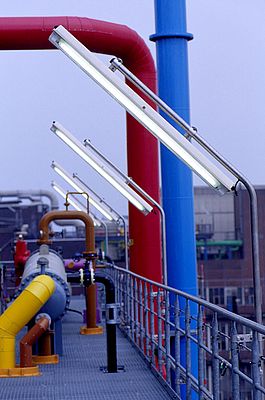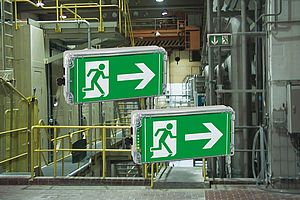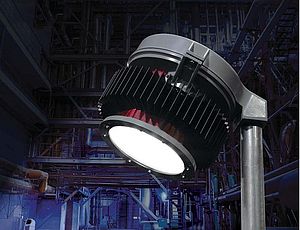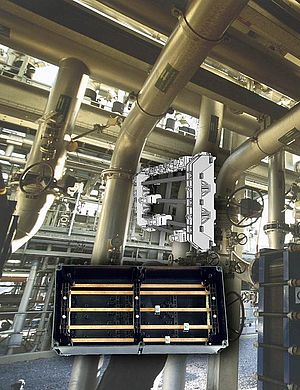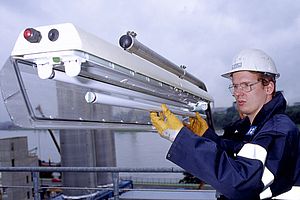Cooper Crouse-Hinds has engineered an explosion-proof fluorescent light fitting for the Chevron-operated Gorgon project. The unique requirements for this project included ensuring that the lighting solution minimised disturbance of the local sea turtle population, whilst also ensuring that the light fittings provide sufficient light, therefore satisfying the Health & Safety requirements of the plant operator, explains Graham Doran of Cooper Crouse-Hinds.
Cooper Crouse-Hinds will supply more than 20,000 explosion-proof (Ex Zone 1 and Zone 2) fluorescent light fittings for installation on the Liquefied Natural Gas (LNG) and domestic gas plant under construction as part of the Gorgon Project - one of the world's largest natural gas projects. Shipping of the light fittings has already commenced, with the lighting units planned for delivery in volume batches throughout 2011 and 2012.
Not only do the light fittings have to meet strict Health & Safety requirements in terms of explosion-protection and ensuring that plant personnel can still distinguish the colour of safety and warning signs at the gas plant, they also have to ensure that disturbance of the local population of sea turtles caused by artificial light sources is minimised. These unique, dual requirements posed enormous engineering challenges for the lighting supplier.
Cooper Crouse-Hinds' standard eLLK 92 fluorescent light fitting with special cover and light filter will be installed in general illumination duties across the gas plant. Cooper Crouse-Hinds will supply four different types of eLLK 92 light fitting, including its 2 x 18W, 2 x 36W standard, and 2 x 36W with battery back-up versions.
The project involves the phased construction of three, 5 million tonnes per annum (MTPA) Liquefied Natural Gas (LNG) plants on Barrow Island, as well as a domestic gas plant with the capacity to provide 300 terajoules per day to supply gas to Western Australia. Gorgon LNG will be offloaded via a 4km long jetty for transport to global markets. The domestic gas will be piped to the Western Australian mainland.
The complexity and sheer scale of Gorgon is unprecedented. The gas field being tapped into contains around 40 trillion cubic feet of LNG. The project is a long term, technically complex energy development that signifies a dramatic advancement in engineering.
The Local Turtle Population
One of the requirements of the Gorgon Project is that plant lighting's disturbance of local turtle populations should be minimised. In other words, any artificial light must not disturb turtle hatchling's orientation towards the sea. Sea turtles and humans perceive light quite differently. Both the colour (wavelength) and relative brightness of light sources are critical in the sea-finding capabilities of hatchling sea turtles. Green turtles, for example, are strongly attracted to light in the near ultraviolet to yellow region of the visible spectrum (360 to 600nm) but are relatively indifferent to light in the yellow-orange to red region (630 to 700nm). The relatively high sensitivity of turtles to short wavelengths is not surprising considering that they live in a medium - the ocean - that selectively filters out long wavelength colours.
Gorgon Primary Lighting Requirements
In terms of the Gorgon processing plant, this means any lighting supplied must adhere to a strict set of requirements. In this case, the primary requirements are that the main light output is greater than 560nm in order to prevent turtles being attracted to the artificial light. The light fittings also have to be fit for use in hazardous industrial, Zone 1 and Zone 2 environments. Another primary lighting requirement on Gorgon is that the colour-rendering index (CRI) of the lighting has to ensure safe working conditions for plant personnel.
According to Willi Steckel, Product Line Manager Lighting (IEC) at Cooper Crouse-Hinds GmbH, in order to solve the CRI issue, 20 to 30 different light filters were tested on the eLLK 92 light fitting. "After we found the appropriate filters, we then tested which one would give us the best colouring with the fluorescent tube. This part of the product testing alone took 8 months to complete. Finally, once we had a good selection of matches, we commenced the UV resistance testing of each filter type," he recalls.
This stage of the testing also involved more than 1,000 hours of colour fade tests carried out in accordance with European Standards (Light Fastness Tests). These ensured that the colour of the filter did not fade under UV influence and maintains its properties for a minimum of 60,000 hours.
Secondary Lighting Requirements
There were also a number of secondary requirements for the lighting. The solution had to use proven technology; provide an optimised light output and optimised turtle orientation response factor; provide maximum time between inspection intervals and use future-compatible technology.
As Graham Doran states: "Our eLLK 92 light fitting is a reliable product, manufactured to superior quality levels and with an excellent reputation for long life and minimal maintenance in hazardous oil & gas installations."
The Recommended Lighting Solution
After more than 2 years of testing and development, Cooper Crouse-Hinds recommended its standard eLLK 92 Ex fluorescent light fittings for Zone 1 and Zone 2 areas, but fitted with a special cover and light filter. The light source is a T8 long life fluorescent white tube with light colour 830.
The light fittings use approved EVG09 ballast, housing and lamps, and are certified to the following standards: BVS 09 ATEX E 034; II 2G Ex de IIC T4. Recommended lamp change interval is 6 years, with a recommended cover change interval of 12 years.
"In my 40 years of working for this company, I cannot remember a project like this one in terms of the complexity of the primary and secondary lighting requirements. The engineering challenges that we've had to overcome on this project required all engineering and technical disciplines within Cooper Crouse-Hinds: R&D, testing, electronics, mechanical, and so on. It was a real collaborative effort here. Everyone here that is involved in the project has been completely driven and motivated to meet these unique challenges and project requirements," enthuses Steckel.


